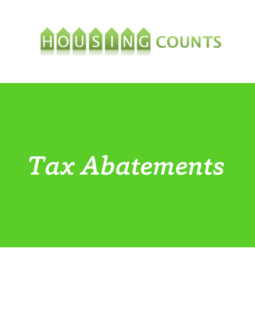Stimulate Construction or Rehab through Tax Abatements
Communities that offer tax abatements or exemptions agree to eliminate tax increases or otherwise reduce property taxes for specific properties. This is done for a designated period of time in order to stimulate a specified public benefit. In the housing sector, real estate tax abatements or exemptions are most commonly used to provide a financial incentive for the construction or rehabilitation of rental homes. Some communities also offer some form of tax abatement or exemption to developers and buyers of homes in designated revitalization zones and/or rental property owners who participate in housing subsidy programs. Abatements or exemptions can be structured in a variety of ways including freezing or reducing the property’s taxable assessed value, reducing the rate at which a property is assessed, or reducing overall property taxes owed. Unlike with tax increment financing, the taxes abated are limited to those of the jurisdiction providing the abatement. Other jurisdictions participate only if specifically agreeing to the abatement.
What problems can tax abatement solve?
Jurisdictions can design policies to address a variety of community concerns, depending on local conditions and priorities. Cities and jurisdictions may use tax abatement to encourage rehabilitation and prevent the loss of existing rental homes. For example, cities may offer to limit real estate tax increases for property owners who upgrade or remodel aging structures while continuing to rent them. Local jurisdictions also may offer tax exemptions as a community development strategy to help stimulate new construction in targeted areas that have experienced disinvestment and decline. By stipulating the inclusion of affordable units as a condition for eligibility, tax abatement policies can further help to increase the supply of homes available to low- and moderate-income households. Finally, tax abatements can be used to prevent displacement and promote participation in subsidized housing programs (by rental property owners) in areas with rising housing costs and property tax assessments.
Where are tax abatement policies most applicable?
Thanks to the broad range of goals that tax abatements and exemptions can help achieve, they can be successfully applied in both strong and weak markets. Tax abatements can help preserve affordability for residents in areas where housing values are rapidly appreciating, but can also be used to stimulate new construction and substantial rehabilitation in neighborhoods in need of revitalization. In developing tax abatement policies, as with any other policy, state and local governments should carefully consider the projected fiscal impact. While abatements generally do not reduce tax revenue, they do limit the additional revenue that may be collected during the term of the abatement. Thus it is necessary to thoroughly analyze and consider each project to be certain that the benefits exceed or equal the cost of the tax abatement.
Reduce property tax for affordable housing.
Minnesota Statute Section 273.128, Subd. 1(4), more commonly referred to as 4d, provides a 40% tax break on housing units that are rent and income limited for lower income residents. This tax reducing method is routinely used by developers of low income tax credit housing and can produce a tax savings of approximately $25-$35 per unit per month. In return, owners commit to rent and income restrictions at 60% AMI or less. This tax reducing method is also available, at a City’s authority, to owners of housing receiving financial assistance from a city if at least 20% of the units are subject to an agreement to provide rent and income limitations. The statute therefore allows cities to accompany financial assistance such as tax increment financing or bond funding with a 4d tax reduction.
Learn more about 4d programs in Minneapolis and Saint Paul.
